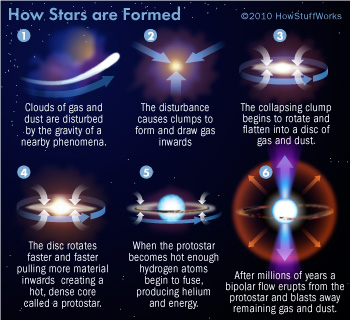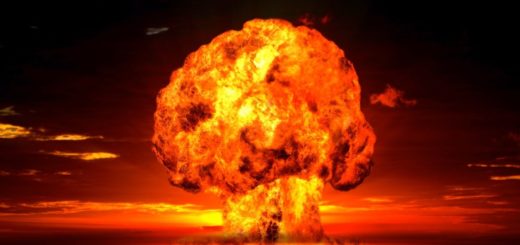How are stars formed?

It’s easy to see why so many world religions deify the sun. It powers life on Earth and holds our entire solar system together. Yet despite all its awe-inspiring brilliance, the sun’s formation follows a specific pattern of cosmic happenstance.
Like so many things in the universe, stars begin very small — mere particles in vast clouds of dust and gas. Far from active stars, these nebulae remain cold and monotonous for ages. Then, like some sleepy little town in a biker movie, everything stirs up when a newcomer speeds through. This disturbance might take the form of a streaking comet or the shockwave from a distant supernova. As the resulting force moves though the cloud, particles collide and begin to form clumps. Individually, a clump attains more mass and therefore a stronger gravitational pull, attracting even more particles from the surrounding cloud.
As more matter falls into the clump, its center grows denser and hotter. Over the course of a million years, the clump grows into a small, dense body called a protostar. It continues to draw in even more gas and grows even hotter.
When the protostar becomes hot enough (7 million kelvins), its hydrogen atoms begin to fuse, producing helium and an outflow of energy in the process. We call this atomic reaction nuclear fusion. However, the outward push of its fusion energy is still weaker than the inward pull of gravity at this point in the star’s life. Think of it like a struggling business that still costs more to operate than it makes.
Material continues to flow into the protostar, providing increased mass and heat. Finally, after millions of years, some of these struggling stars reach the tipping point. If enough mass (0.1 solar mass) collapses into the protostar, a bipolar flow occurs. Two massive gas jets erupt from the protstar and blast the remaining gas and dust clear away from its fiery surface.
At this point, the young star stabilizes and, like a business that finally becomes lucrative, it reaches the point where its output exceeds its intake. The outward pressure from hydrogen fusion now counteracts gravity’s inward pull. It is now a main sequence star and will remains so until it burns through all its fuel.
What is the life span of a star? It all depends on its mass. A star the size of our sun takes roughly 50 million years to reach main sequence and maintains that level for approximately 10 billion years [source: NASA]. Astronomers classify the sun as a g-type main sequence star — the “g” indicates the sun’s temperature and color.
Larger, brighter stars burn out far faster, however. Wolf-Rayet stars boast masses at least 20 times that of the sun and burn 4.5 times as hot, yet go supernova within a few million years of reaching main sequence [source: NASA].
Explore the links below to learn even more about life and death in the cosmos.



 Creators of mankind
Creators of mankind Description of “Tall white aliens”
Description of “Tall white aliens” Where they came from?
Where they came from? About hostile civilizations
About hostile civilizations The war for the Earth
The war for the Earth “Tall white aliens” about eternal life
“Tall white aliens” about eternal life Video: “Nordic aliens”
Video: “Nordic aliens” Aliens
Aliens Alien encounters
Alien encounters The aliens base
The aliens base UFO
UFO Technology UFO
Technology UFO Underground civilization
Underground civilization Ancient alien artifacts
Ancient alien artifacts Military and UFO
Military and UFO Mysteries and hypotheses
Mysteries and hypotheses Scientific facts
Scientific facts


















